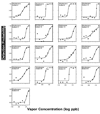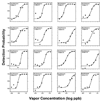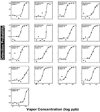Olfactory detectability of homologous n-alkylbenzenes as reflected by concentration-detection functions in humans
- PMID: 19303922
- PMCID: PMC2751591
- DOI: 10.1016/j.neuroscience.2009.03.029
Olfactory detectability of homologous n-alkylbenzenes as reflected by concentration-detection functions in humans
Abstract
As part of our systematic exploration of chemical determinants for the olfactory potency of vapors towards humans, we measured concentration-detection functions for the odor of the homologous n-alkylbenzenes toluene, ethylbenzene, butylbenzene, hexylbenzene, and octylbenzene. A vapor delivery device based on dynamic olfactometry and calibrated by gas chromatography, served to test groups of 16 to 17 participants. Subjects were young adults from both genders, normosmics, and nonsmokers. Odor functions were tightly modeled by a sigmoid (logistic) function, both at the group and the individual level. Odor detection thresholds (ODTs), defined as the concentration producing a detectability halfway between chance and perfect detection, decreased with alkyl chain length from toluene (79 ppb) to butylbenzene (2.5 ppb), and then increased form butyl to octylbenzene (89 ppb). The "U"-shaped trend of ODTs as a function of alkyl chain length indicated a loss of odor potency beyond a certain molecular size, a phenomenon recently described for chemosensory irritation (chemesthesis) and that will need consideration in structure-activity models of chemosensory potency. Interindividual ODTs' variability for any single odorant amounted to one order of magnitude, in agreement with recent studies of other homologous series but quite smaller than commonly depicted.
Figures








Similar articles
-
Structure-activity relationships on the odor detectability of homologous carboxylic acids by humans.Exp Brain Res. 2010 Nov;207(1-2):75-84. doi: 10.1007/s00221-010-2430-0. Epub 2010 Oct 8. Exp Brain Res. 2010. PMID: 20931179 Free PMC article.
-
Odor detection by humans of lineal aliphatic aldehydes and helional as gauged by dose-response functions.Chem Senses. 2010 May;35(4):289-99. doi: 10.1093/chemse/bjq018. Epub 2010 Feb 26. Chem Senses. 2010. PMID: 20190010 Free PMC article.
-
Olfactory psychometric functions for homologous 2-ketones.Behav Brain Res. 2009 Jul 19;201(1):207-15. doi: 10.1016/j.bbr.2009.02.014. Epub 2009 Feb 21. Behav Brain Res. 2009. PMID: 19428635 Free PMC article.
-
Dose-Response Functions for the Olfactory, Nasal Trigeminal, and Ocular Trigeminal Detectability of Airborne Chemicals by Humans.Chem Senses. 2016 Jan;41(1):3-14. doi: 10.1093/chemse/bjv060. Epub 2015 Oct 17. Chem Senses. 2016. PMID: 26476441 Review.
-
The perception of odor is not a surrogate marker for chemical exposure: a review of factors influencing human odor perception.Clin Toxicol (Phila). 2013 Feb;51(2):70-6. doi: 10.3109/15563650.2013.767908. Clin Toxicol (Phila). 2013. PMID: 23387344 Review.
Cited by
-
Disentangling linear and nonlinear brain responses to evoked deep tissue pain.Pain. 2012 Oct;153(10):2140-2151. doi: 10.1016/j.pain.2012.07.014. Epub 2012 Aug 9. Pain. 2012. PMID: 22883925 Free PMC article.
-
An algorithm for 353 odor detection thresholds in humans.Chem Senses. 2012 Mar;37(3):207-18. doi: 10.1093/chemse/bjr094. Epub 2011 Oct 4. Chem Senses. 2012. PMID: 21976369 Free PMC article.
-
Making scents: dynamic olfactometry for threshold measurement.Chem Senses. 2010 Feb;35(2):109-20. doi: 10.1093/chemse/bjp088. Epub 2009 Dec 4. Chem Senses. 2010. PMID: 19965900 Free PMC article.
-
Structure-activity relationships on the odor detectability of homologous carboxylic acids by humans.Exp Brain Res. 2010 Nov;207(1-2):75-84. doi: 10.1007/s00221-010-2430-0. Epub 2010 Oct 8. Exp Brain Res. 2010. PMID: 20931179 Free PMC article.
-
Hydrogen bonding between solutes in solvents octan-1-ol and water.J Org Chem. 2010 Nov 19;75(22):7651-8. doi: 10.1021/jo1014646. Epub 2010 Oct 18. J Org Chem. 2010. PMID: 20954704 Free PMC article.
References
-
- Abraham MH. Scales of solute hydrogen-bonding: Their construction and application to physicochemical and biochemical processes. Chem Soc Rev. 1993;22:73–83.
-
- Abraham MH, Gola JMR, Cometto-Muñiz JE, Cain WS. A model for odour thresholds. Chem Senses. 2002;27:95–104. - PubMed
-
- Abraham MH, Ibrahim A, Acree WE., Jr Air to blood distribution of volatile organic compounds: a linear free energy analysis. Chem Res Toxicol. 2005;18:904–911. - PubMed
-
- Abraham MH, Ibrahim A, Acree WE., Jr Air to brain, blood to brain and plasma to brain distribution of volatile organic compounds: linear free energy analyses. Eur J Med Chem. 2006;41:494–502. - PubMed
-
- Abraham MH, Ibrahim A, Acree WE., Jr Air to lung partition coefficients for volatile organic compounds and blood to lung partition coefficients for volatile organic compounds and drugs. Eur J Med Chem. 2008;43:478–485. - PubMed
Publication types
MeSH terms
Substances
Grants and funding
LinkOut - more resources
Full Text Sources
Research Materials

